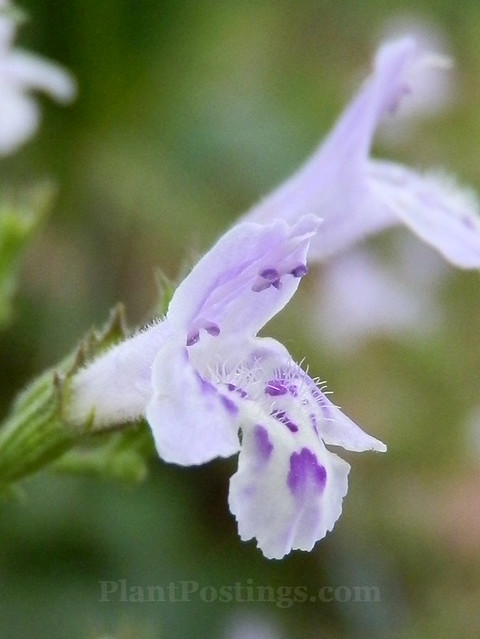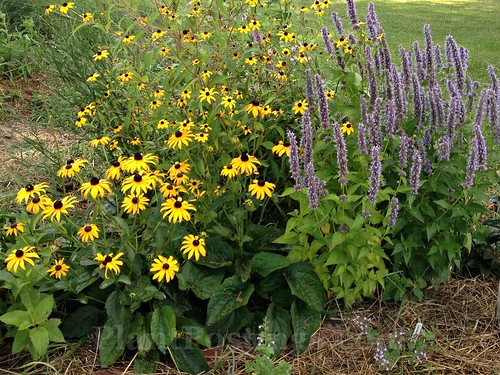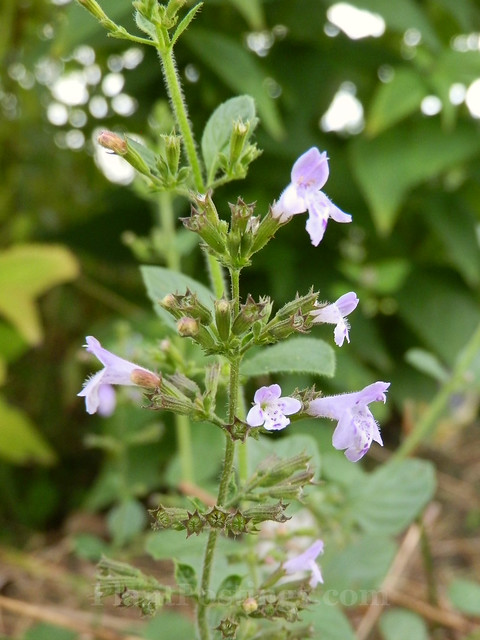
Need a low-growing, prolific bloomer for a sunny garden spot or border? Calamintha nepeta subsp. nepeta might be the plant for you. Nicknamed Lesser Calamint, this mound-forming perennial blooms from June to first frost, and sometimes afterward. It's hardy in USDA zones 4 to 9, according to Midwest Groundcovers, which shares some excellent photos of the plant in full bloom at maturity.
The first photo in this post is deceptive: I'm estimating each flower is about one-quarter the width of my pinky finger. I enlarged and cropped the photo so you could see the detail of the tiny, lavender/white blooms.

You get an idea of the scale of the individual flowers from the photo above: The Lesser Calamint plants shown here are the smaller ones with plant stakes along the front border of a pollinator garden. The flowers grow along a spiking stem in profusion during the summer. The plants in this photo are first-year plants. When mature, they reach heights and spreads of about one to two feet.

I discovered this plant during a late autumn 2013 trip to Olbrich Botanical Gardens, in Madison, which has sold Lesser Calamint during its plant sale for the past few years. Even in late fall, the plants there were covered with a diverse range of pollinators. This plant is low-maintenance and drought-tolerant, according to the Missouri Botanical Garden. (Information about Lesser Calamint in this post comes from these two sources and my own experience.)
The subspecies nepeta is sterile, so it won't re-seed. It forms a shrub-like mound of foliage, out of which the flower stems emerge in late spring.

This slightly closer view of the foliage and the flower stems shows how airy and light they are.
Other facts about Lesser Calamint:
- The leaves of this Mint-family plant are edible as a tea or as an herb, with scent and flavor reminiscent of Oregano and Mint;
- It prefers full sun, but tolerates afternoon shade, and prefers dry to medium moisture levels;
- No serious insect or disease problems; and
- The minty scent deters deer and rabbits.
It's an attractive and wildlife-friendly plant that has the added benefit of being edible.

Sweet! I will be keeping my eyes open at the garden centers.
ReplyDeleteI know: I want to add it to my garden, too, but I don't have enough sun. I might try it in dappled sun, or add it to a sunny border in the front yard. I know there are several sources for ordering it online.
DeleteIt's on my want list...although I'm nervous because I've heard it needs good drainage, which generally speaking, does *not* describe my garden :P
ReplyDeleteYours looks great. Love plants that attract pollinators :-)
Ah, yes, that could be a problem with clay soils! The soil here and at the pollinator garden where I planted it is silt/loam--perfect garden soil. I don't have any in my own garden because of the lack of sun. :( But I have a sunny patch in mind...
DeleteIn Tennessee, I've found that some plants advertised as "full sun" seem to do fine in partial shade / dappled shade.
DeleteNot sure if the same would hold true in Wisconsin... I suspect our "full sun" may be a bit more intense...
You're tempting me to try it here in my "partial shade" garden, Aaron!
DeleteIt looks like a really attractive and carefree plant. I like plants that are useful, too.
ReplyDeleteYes, and the nepeta subspecies is the best because it doesn't re-seed. So, it's a great plant to support honey bees and native bees--they both love it!
DeleteAnything that deters deer and rabbits works for me! I have 'Walker's Low' which is very reliable. I like this one, too. P. x
ReplyDeleteI know--rabbits are a huge problem in my garden! I wish this plant would thrive in shade. I'm considering adding it to a part shade spot. Or maybe to a sunny border in the front yard.
DeleteSweet looking plant, and a beautiful colour...
ReplyDeleteAmanda xx
It's a pleasant, carefree plant. The color looks more like white at first, then becomes more lavender as the season progresses. :)
DeleteSuch a pretty little bloom.
ReplyDeleteYes, it's a cutie! I want some for my own garden!
DeleteLike Pam, I have Walker's Low. It is a plant that makes a big show. The Lesser Catmint is delicate looking which can be very pleasing in a garden of light-as-air, ethereal plantings.
ReplyDeleteI like 'Walker's Low,' too. The Lesser Calamint is great for front borders, and I'm hoping, over time, will help to keep critters out of the pollinator gardens I set up. Even the foliage, alone, is lovely in early to mid-spring before it blooms.
DeleteOooh, that would work here, but I'll bet it would struggle in our heat. That first photo is breathtaking-though all are terrific. I'll keep an eye out for this gorgeous perennial.
ReplyDeleteThanks! I wonder if it would work in partial sun in Texas? I know there are several sources for ordering it online.
DeleteHow pretty! What a great little plant, especially as long flowering perennials seem not to be very common.
ReplyDeleteYes, that's a good point, Margaret. That's why I'm thinking about adding it to my main perennial bed. I've been trying to add mainly native plants, there, but the rabbits are nibbling them down. So if this would survive in partial sun, it just might help me keep the rabbits away from those spots. ;-)
DeleteDeters rabbits? I need it!
ReplyDeleteAmen! Oh, the stories I could tell. It goes on and on. The only thing that really works is to plant plants they don't like (like this one) or to put tall chicken wire fencing around the plants. But you can't fence in the entire garden!
DeleteThank you for this very interesting plant portrait!
ReplyDeleteYou're most welcome, Alain. It's fun to pick a plant to profile each month. The list never ends! ;-)
DeleteJune is such a floriferous month that a plant has to be really something to ear "plant of the month". I'll have to look into this.
ReplyDeleteYes, true. I happened to notice that the Calamints I planted last year are thriving this year. So it seemed appropriate to highlight them. Plus, they're great pollinator plants. :)
DeleteOne of my favorite plants. I have several. They are great cascading over a low wall, spreading as a ground cover in soils most plants won't grow in, and, as you mentioned, bees love them.
ReplyDeleteYou've just given me a great idea! Thank you! The Calamints shown in the pollinator garden here are ones I planted for other gardens. I want them in my own garden. Your comment gave me an idea where to put them. Thanks!
Deleteso pretty, I like the color
ReplyDeleteYes, the color is very understated until you get very close. :)
DeleteOver the last few years I think I have bought about a dozen plants of this at Olbrich after seeing it in their gardens.
ReplyDeleteI remember you telling me you liked this plant, too. Lucky you, to have it in your garden! The ones I've planted have been for other gardens. Now I'm gathering ideas about little spots of sun where they would thrive here.
DeleteI have a bunch of calamint although some of it didn't make it through last winter and what came up has been severely damaged by insects. The bees really do love the blooms, though. There's lots of it at the Chicago Botanic Garden.
ReplyDeleteThe ones at the pollinator garden I worked on are going gangbusters this year. They're in bright sun most of the day. I hope I can find a sunny-enough spot for them in my garden, otherwise I think they would struggle.
DeleteI have some plain old catmint and some annise hyssop, which is similar to these. That is a nice looking plant, too. Thanks for your comments on my last couple of posts. Now that we are not having all that rain, it has been hot, and there are now big cracks in the soil. The rabbits are still at it, but I am not seeing as much new damage. Maybe the babies are leaving to find other yards to feed in.
ReplyDeleteHi Sue: You are welcome: I enjoy visiting your blog. I have Anise Hyssop, too. It's much taller than the Lesser Calamint, but they're great companion plants, as shown in some of the photos. We have been uncharacterstically mild here for June. Looks like July will be warmer, which is fine by me. Rabbits are always the bane of my existence. ;-)
DeleteOh, what a great plant! I've actually been looking for some native plants that would be good ground covers, and that fits the bill. Does it spread quickly?
ReplyDeleteHi Indie: This is not a native plant. But the sterile species, Calamintha nepeta subsp. nepeta, doesn't re-seed, so it doesn't spread as much. It definitely has ecological value because the pollinators (of all types) love it. It does take a couple of seasons to get going, but then it spreads by the roots. I don't sense that it would become invasive, though.
DeleteI love that first picture, so lovely. We are also starting with our rainy season and in a few weeks the flowers will rise together with the butterflies. Oh my hands will again be filled with so much job with the hoyas and with the camera. I might not be able which ones to do first. I wont be able to look elsewhere for the photos, they will just be around the house. Happy shooting to you as well.
ReplyDeleteThanks! Oh, yes, the rainy season will be good for your Hoyas. Glad to hear you will soon have the joy of butterflies, too. Enjoy!
DeleteVery pretty, and being sterile it is very suitable for small gardens so you don’t have to clear it from every single bed for years to come :-)
ReplyDeleteYes, definitely good for small gardens, and for areas where you don't want it to expand too much into other planting areas.
DeleteI love running my fingers through Calamint to bring that scent to my nose.
ReplyDeleteAgreed! I find it a gift for all the senses--the scent, the taste, the beauty, the soft touch of the foliage, even the rustle of the wind through the leaves. And of course, the buzz of the bees moving through the tiny flowers. :)
DeleteNew plant to me and helpful information... Michelle
ReplyDeleteI didn't know much about it until recently, either, Michelle. Now I'm trying to find a sunny spot for it in my garden. :)
DeleteAnd very pretty it is too. A lovely post , I don' t grow this but you have convinced me that I should give it a try.
ReplyDeleteThank you, Chloris. This would be a good one for you, since I believe C. nepeta is native to the U.K. It's a lovely little mound-forming plant.
DeleteI have heard of this plant before, but I am still a bit confused as to whether it is related to the catmints which are also part of the Nepeta family. I have forgotten what little botany I learned, so maybe they are just cousins:) Nice to know there is a sterile species, as I shy away from anything that has mint in the name.
ReplyDeleteI get confused with these, too, Rose. They're both in the mint family, but different genuses. Catmint is in the Nepeta genus, and Calamint is in the Calamintha genus. I guess that means they're cousins, right? ;-) Yes, the sterile subspecies is definitely the way to go where this plant isn't native!
DeleteI have this and the bees love it. :o) Plus, it's a really tough plant.
ReplyDeleteGood to know, Tammy. I'm relatively new to it, so it's helpful to know it's a survivor. The bees seem to like it in the pollinator garden I worked on, and it seems to be thriving in its second year. :)
DeleteIt's drainage needs would hamper it here in my garden. It's a pretty wee thing never the less and the fact that it's loved by the bees is the best reason for growing this lovely wee thing.
ReplyDeleteYes, the facts that the bees like it and it's attractive and has such a nice shape makes me want it in my own garden. Trying to find a good place ...
DeleteA pretty and useful plant!
ReplyDeleteYes, that is a good combination, isn't it?
DeleteWonderful photos - especially the first one. The hairs on the lower lip are amazing.
ReplyDeleteThank you, Tim. I enlarged and cropped, but I was surprised with how the detail was still decent. These are very tiny flowers.
DeleteWonderfull summer flowers and macro,greeting from Belgium
ReplyDeletehttp://louisette.eklablog.com/
Thanks for stopping by! Macro Monday is a fun meme. :)
DeleteThe words 'little' and 'mound forming' are music to my ears! I have too many long - legged sprawlers at the moment so I shall be looking out for it !
ReplyDeleteYes, it has a nifty little shrub-like form. It looks very lush in the spring and summer, and then still has flowers in the fall. Very pretty.
DeleteLovely! The flower reminds me of a small Penstemon. It looks like a great companion for one of its cousin Catmint/Nepetas. Sorry, I get confused when plants share the same name but one is for the genus and the other the species. :-( My Catmints do OK in my clay, but I get the feeling from your comments that Calamints need looser soil.
ReplyDeleteI know, I get confused with the Catmint/Calamint/Nepeta/Calamintha names/plants, too. To be honest, I've only tried to grow Calamintha nepeta nepeta in very high-quality soil. So, I don't know how it would do in clay. Might be worth trying if the soil is amended.
DeleteLovely, and non-invasive! I also like its lower-growing habit.
ReplyDeleteYes, it is a good choice for something that fills in nicely but isn't invasive. I really want to add it to my own garden, but I have mostly shade. Argh.
DeleteGorgeous flowers and plants! Lovely images. Enjoy your day!
ReplyDeleteThank you, Eileen! Hope you're having a great summer!
DeleteEmily says it's a cousin to catmint. I've never heard of calamint - hmm, very interesting, I prefer catmint but then I'm prejudiced! Love seeing the bees...
ReplyDeleteHi sue catmint: Actually, I got the "cousin" idea from Beth in her response to Rose above. It sounded good to me :-)
DeleteLOL. Yes, I guess they're both in the same family but different genera. I added a bit of Catmint to the same garden (it's a pollinator garden at a food pantry garden). Most of the plants are native Midwestern plants, but those two are planted around the perimeter for the honeybees, and because of their low-growing, border-friendly habits. ;-)
DeleteLooks like a sedater version of nepeta and altogether more well-behaved. Although the two would look good together - in my imaginary garden catmint (Nepeta mussinii) grows en masse in open borders where it lures in the bees like iron filings to a magnet - and the cats - though not as much as catnip (Nepeta cataria)!
ReplyDeleteYes, that sounds about right. There are two small bits of Catmint in the same gardens as the Calamint. They make good border plants and the bees love them, yes!
DeleteNepetas are such a wonderful flower and grow so well here too. I have some very low growing ones as well that are a great ground cover. And the hummers love them too!
ReplyDeleteI haven't seen hummers at the Calamintha or the Catmint in this particular garden, although I wouldn't be surprised. The bees love all of the plants in the pollinator gardens. :)
Delete